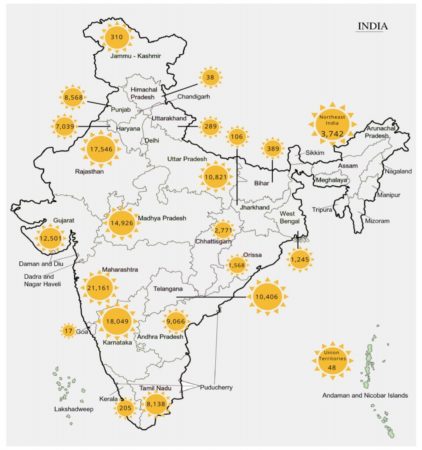India’s Solar Goals can be met by Solar Pumps

Solar powered pumps, if used in large enough numbers to replace existing pumps across India, could potentially help India surpass its solar target of 100 GW by 2022.
This analysis was released at a roundtable conference hosted by Greenpeace India, GERMI, and IWMI-Tata Program to discuss steps necessary for the successful implementation of KUSUM (an acronym for Kisan Urja Suraksha Evam Utthan Mahaabhiyan) – a central government scheme promoting solar irrigation pumps, that was announced in the last budget. Representatives from leading think-tanks, farmer groups, and related services attended.
According to the report if 100% of India’s agricultural consumption were to be replaced in the next five years with net-metered solar pumps, it would require a total solar PV installed capacity of close to 150 GW. Individually greater than the entire distributed 100 GW target set by India for 2022 and a little farfetched. However, even if a minor 10-20% of that target can be achieved over the next 5 years, that will account for a massive 15-30 GW of installed solar capacity. These grid-connected, net metered solar pumps will also play an important role in providing secondary income to farmers, while giving them access to quality power for irrigation during the day.
“To achieve its 2022 renewable energy targets, the government needs to look for creative ways of implementing decentralised renewable energy schemes. It’s clear that KUSUM is an innovative scheme that fits the bill, but unfortunately, it is yet to get cabinet approval and receive finance allocation,” said Pujarini Sen, Renewable Energy Campaigner, Greenpeace India.
Following the recent trends in development around the solar sector it is safe to assume that India’s 60 GW large scale solar target for 2022 is on track. But, of the planned 40 GW of rooftop installations a meagre 2.4 GW has been achieved so far, and the market or even policy prescriptions don’t suggest any boom in the sector in the near future. It’s a point we have also made , repeatedly, at IamRenew.
“Net metered solar farm top installations are very similar to rooftop solar installations from a technical standpoint. However while rooftop solar PV systems take away high paying consumers from the grid, farm top systems will actually reduce the agricultural subsidy burden for India’s cash-strapped power utilities. “Farmtops” are an excellent way to achieve scale across the country,” said Akhilesh Magal, Head – Advisory, Renewable Energy, Environment, and Energy Efficiency, GERMI.
Potential Benefits of net-metered Solar Pumps,
1. Provide high-quality daytime power,
The high quality solar pumps can provide farmers with power during the day. Since the pumps are net-metered, the farmers always have an option of drawing power from the grid in case of an excessively cloudy day or when the pumps are down due to any technical issue. This will insulate the farmer from any risks associated with down-times. Similarly, in case the fields do not need irrigation, the solar array can feed power into the grid.
2. Additional Income for Farmers,
Net-metered pumps not only cater to the farmers own consumption, but if sized adequately, can result in excess power that can be fed into the grid. Farmers can earn money for the power injected into the grid, quite similar to the rooftop net-metering scheme.
3. Reduction of Subsidy Burden on State Government and Cross
Subsidy on DisComs,
Power for the agricultural sector is either free or priced nominally. While the price of power procurement has gone up over time, agricultural power prices have not reflected this trend. This has resulted in two things:
1) increase in the extent of State Government Subsidy often disbursed to the Discoms via the annual tariff petition process and,
2) increase in the cross subsidy from the industrial and commercial segments. Solar pumps can provide energy independence to farmers and sever the dependence on subsidies. The lack of running fuel costs, as in the case of diesel pumps, is another economic benefit.
4. Reduction in the exploitation of underground water,
There is ample evidence to suggest a strong correlation between subsidized energy access and groundwater exploitation. While solar pumps do provide high quality power for irrigation purposes during the day time and plug in an incentive for farmers to use water efficiently and divert power into the grid in order to earn additional revenue. This choice will certainly depend on several factors such as the quantum of incentive, the season and market price for crops being grown. However for the first time, farmers could have the ability to make a choice.
While the project will have to tackle a few obstacles like getting farmers on-board with the project and getting not just one but all the farmers in a region to abide by a certain set of rules which will be so designed to benefit them all and the state. The other issue of quality of equipment used in the projects and their maintenance, need to be addressed more importantly. A specific task force could be set up to undertake this responsibility. However, the benefits outweigh the risks.
“If promoted well, through feeder-level farmer institutions, grid-connected solar pumps can have multiple benefits: offer farmers a stable source of climate-proof income; incentivize farmers to become efficient energy and groundwater users; significantly reduce India’s annual farm power subsidy burden; improve the financial viability of India’s electricity utilities; significantly contribute to meeting India’s RE targets; and reduce the carbon footprint of India’s groundwater irrigation economy,” said Shilp Verma, IWMI-Tata Water Policy Program.
The analysis also found that Maharashtra has the highest farm top solar potential with 21.1 GW, followed by Karnataka (18 GW), Rajasthan (17.5 GW), Madhya Pradesh (14.9 GW), Gujarat (12.5GW), Uttar Pradesh (10.8 GW) and Telangana (10.4 GW).
 (All units in MW, source: Greenpeace India)
(All units in MW, source: Greenpeace India)
The Finance Minister had mentioned the KUSUM scheme in his speech during the Union Budget in February 2018 and Minister of Power, Mr. R K Singh had promised that the scheme would be rolled out in July, though disagreements with the Finance Ministry have also been reported and the bill is yet to be cleared. Net-metered solar pumps have the potential to turn around the power sector in India.



